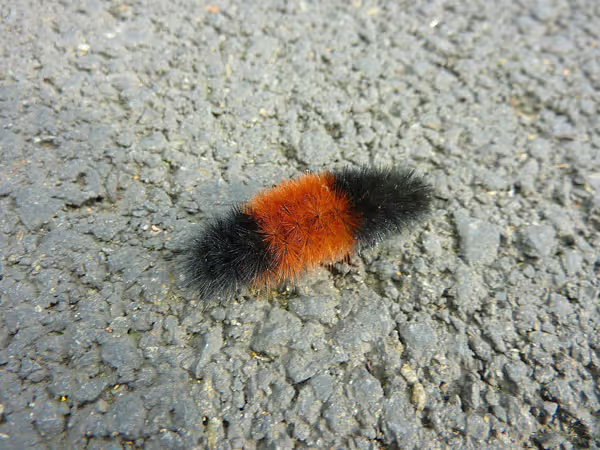Woolly Bears and Winter Weather Predictions


Fall is here along with all of its tidings: school supplies, football, pumpkin spice, and woolly bears. Woolly bears (the larval form of Pyrrharctia isabella, or tiger moths) are the cute and fuzzy, rust-and-black banded caterpillars that seem to be everywhere this time of year. Wooly bears are also known as “woolly worms,” “fuzzy bears,” and “hedgehog caterpillars,” because of their tendency to curl into balls when threatened. Woolly bears, and adult tiger moths, can be found throughout North America. They hatch in warm spring and summer months, but we tend to see them most often in the fall. This is the time of year when a woolly bear will leave its food plants in search of a sheltered space to hibernate through the upcoming winter.
Before groundhogs and their shadows announce the coming of spring, it has been said that woolly bears—and their bands, fuzz, and migration patterns—could be observed to forecast winter weather conditions.
A woolly bear with a wide, rust-colored band around its midsection was said to be a sign of a mild winter, while longer, blackish bands at both ends indicated a snowy, severe season ahead. Taking a closer look, the position of the longest dark portion was thought to show which part of winter would be the most severe. For example, if the tail end had the largest dark band, the end of winter would be cold, while a larger band near the head meant a severe start to the season.
We now know that the coloring or length of a woolly bear’s bands do not correspond with the upcoming season’s weather, but the truth is not so far off (well, part of the truth, anyway). A woolly bear’s bands can actually relate to the previous season’s conditions. The length of time in which the woolly bear was able to feed is one factor that could affect the caterpillar’s coloring. The woolly bear has a better chance of growing longer during a fruitful season, which will result in a narrow rusty band around its midsection. Other factors that could affect the woolly bear’s bands are age and species. The woolly bear will molt six times before adulthood, and the rusty band will grow with each molt. On top of that, each species of the caterpillar has slightly different coloring and appearance—and there are approximately 260 species of woolly bears in North America!
Another theory about woolly bears and weather prediction focused on their trademark wool, or “setae,” the hairlike bristles that woolly bears appear to be covered in. This theory suggested that the length of a woolly bear’s setae corresponded with winter weather. A fuzzier woolly bear was a sign of a cold snap, while less or shorter fuzz indicated a mild season.
In actuality, setae doesn’t protect the woolly bear from the cold; setae helps the woolly bear control its temperature as it freezes during hibernation. The hibernation process will begin once the woolly bear has found shelter inside a crack of a log, pile of leaves, cavity of a rock, or another dark and covered space. Then, the woolly bear’s setae will sense the cold and trigger the freezing process. The woolly bear will freeze incrementally as a “natural antifreeze” protects its cells. Once the seasons change again, the woolly bear will thaw, eat whatever plants it can find, and begin creating its cocoon from its setae and silk. In early summer, an adult isabella tiger moth will emerge from the cocoon.
One final myth about woolly bears and weather prediction is that the direction of their migration corresponded with winter weather. A woolly bear heading south was said to be a sign of a cold front coming in, while a northbound bear indicated mild weather. Woolly bears tend to travel in search of food and hibernation spaces and do not seem to be deterred by weather conditions. While woolly bears might just seem like cute, fuzzy little caterpillars, they are incredibly tough and can survive in even the coldest of temperatures!
With winter on the horizon, the Pacific Northwest is heading into our dark, stormy season and some of us may be entering into our own forms of Netflix-fueled hibernation. It’s only a matter of time, though, before the woolly bears emerge, spin their fuzzy cocoons, and prepare for their transformations into moths and a summer in the sky.
Sources:
Boeckmann, Catherine. “Do Woolly Bear Caterpillars and Weather Prediction?” The Farmer’s Almanac, https://www.almanac.com/woolly-bear-caterpillars-and-weather-prediction. Accessed 30 September 2021.
“Woolly Bear Caterpillar Hibernation.” Adirondack Almanac, https://www.adirondackalmanack.com/2019/11/woolly-bear-caterpillar-hibernation.html. Accessed 2 October 2021.
“Woolly Bear Caterpillar - Winter Predictor or Not?” National Weather Service, https://www.weather.gov/arx/woollybear. Accessed 30 September 2021.
Image by Davgood Kirshot from Pixabay
© Holly Duffy, October 2021
Touch whale bones, examine shipwreck artifacts and connect with the coast's living history.

Support our mission, get involved in educational programs, or contribute through donations and volunteering.